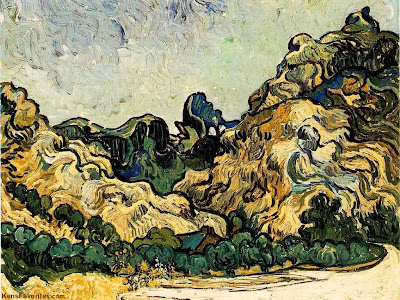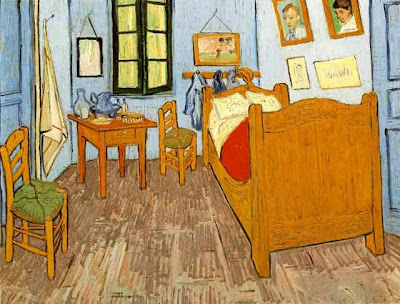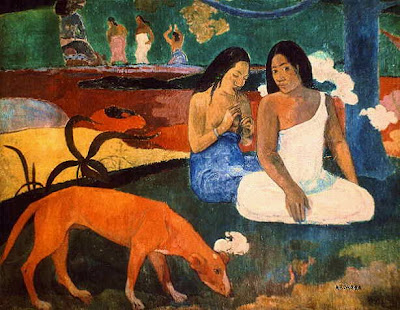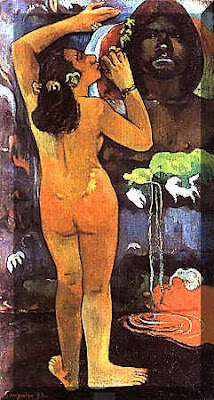Saturday, May 05, 2007
THE PRICE WE PAY FOR STORY
[NOTE: Blogger (or is it YouTube?) doesn't support archived YouTube videos that are more than a year or so old. This post relies on video reference and suffers from the loss. Even so, the text is still worth reading and the subject is an important one.]
I like a good story, even in short TV cartoons (this page is about TV shorts), but I sometimes have to remind myself that story comes at a price, sometimes a very high price.
It's a case of losing something to gain something. With story-emphasis you lose or drastically reduce the likelihood of humor, good music, memorable performance, innovation, atmosphere, funny cartooning and funny animation. What do you get in return? So far as I can tell...momentum. You're less likely to get up to get a cheese sandwich if you're wondering whether Scooby Doo and his friends will discover that corrupt real-estate dealers are behind the so-called haunted house. Is the price worth it? Watch the story-light cartoons on this page and judge for yourself.
One of the greatest casualties of today's extreme story emphasis has been music. Can any story that animation writers are likely to come up with match the entertainment value of Cab Calloway's band in the "Snow White" film above (topmost)? Nowadays studio musicians are given a cartoon after it's already been written and animated. Musicians are almost an afterthought when budgets are figured out. Does that make sense? Isn't music the most fundamental of all the arts?
And what about atmosphere and texture? How do you like the atmosphere in "Mysterious Mose" (second film from the top, above)? Would a cartoon with story emphasis have had time to play out the rich atmosphere and gags in Betty's bedroom? Would the story that replaced the atmosphere likely have been as memorable or as funny? Would "Bimbo's Initiation" (above) have been improved with the addition of more story?
[Chuck Jones came up with a memorable story for "Scaredy Cat" (later remade as "Claws for Alarm") but that was more a situation than a story. Arguably situations fit short subjects a lot better than stories.]
Another casualty of story has been performance. Great cartoon performances need time to play out. Story-emphasis cartoons are always racing ahead to the next plot point. What's the rush? We have to remind ourselves that stories exist to justify and give context to great performances. Audiences crave great performances, that's why we have the Oscars every year.
Thursday, May 03, 2007
Wednesday, May 02, 2007
Monday, April 30, 2007
THEORY CORNER FOR KIDS: A BEDTIME STORY
 I know a lot of kids read this blog so here's something for them. It's a really sweet little story called "The Pokey Little Animation Writer." The story starts in a suburban bedroom where Billy's parents are roused out of their sleep by a knock on the bedroom door....
I know a lot of kids read this blog so here's something for them. It's a really sweet little story called "The Pokey Little Animation Writer." The story starts in a suburban bedroom where Billy's parents are roused out of their sleep by a knock on the bedroom door.... Knock! Knock! Knock! "Huuuh?" said Dad, waking suddenly. "Who...Wha...Wh...Who's there? For Pete's Sake, stop knocking!"
Knock! Knock! Knock! "Huuuh?" said Dad, waking suddenly. "Who...Wha...Wh...Who's there? For Pete's Sake, stop knocking!"  "URGES!? Oh, Bashaw! What kind of urges could you have at your age?
"URGES!? Oh, Bashaw! What kind of urges could you have at your age? "Well Dad, I know it's strange but I have an urge to find an animation artist and beat him up. I know it doesn't make sense but I get really mad at the thought of artists writing and directing their own stories. I guess that's silly isn't it? I mean, why should I get mad about what artists do?"
"Well Dad, I know it's strange but I have an urge to find an animation artist and beat him up. I know it doesn't make sense but I get really mad at the thought of artists writing and directing their own stories. I guess that's silly isn't it? I mean, why should I get mad about what artists do?"
 "But Dad...won't the artists feel bad if we take their medium away from them?"
"But Dad...won't the artists feel bad if we take their medium away from them?" "Naw," said Dad, "they don't have feelings like we do! If they had feelings they'd be writers like us. They just have...notochords!"
"Naw," said Dad, "they don't have feelings like we do! If they had feelings they'd be writers like us. They just have...notochords!" "Now get to sleep, Buckaroo! If you're good I'll take you out hunting tomorrow! If we find an artist directing a cartoon we'll trash him and you can break his pencils!"
"Now get to sleep, Buckaroo! If you're good I'll take you out hunting tomorrow! If we find an artist directing a cartoon we'll trash him and you can break his pencils!" THE END
Sunday, April 29, 2007
SHOULD CARTOONISTS TAKE LIFE DRAWING CLASSES?
 Good question! My answer is yes...but with caution! We're cartoonists after all and not illustrators. A cartoonist can actually pick up bad habits in a life drawing class.
Good question! My answer is yes...but with caution! We're cartoonists after all and not illustrators. A cartoonist can actually pick up bad habits in a life drawing class.
I don't know about you but when I draw undraped models I'm always shocked by the drama and profundity of the body. The human machine is awesome. Layer over that the nuances of intellect and personality and you have a very appealing subject to draw.
The problem is that it's too appealing. If you're like me, no matter how much you may have resolved to caricature the model (whole-body caricature) , the moment you see her all you can think to do is to revert to stark realism. Anything else seems unfit for the importance of the subject. This is why you have to double your resolve to caricature. If you have trouble doing this then you should pose the model draped for half the session.
 Another problem is that realistic life drawing encourages scratchy lines. Realists tend to search for the forms with lots of tentative strokes til they get what they want. Cartooning isn't like that. A cartoonist needs to learn strong, confident lines.
Another problem is that realistic life drawing encourages scratchy lines. Realists tend to search for the forms with lots of tentative strokes til they get what they want. Cartooning isn't like that. A cartoonist needs to learn strong, confident lines.
 Some cartoonists put their best effort into realistic life drawing because they're frustrated with the way their cartoons are turning out. Life drawing becomes a sort of holding pattern where they concentrate on general draughtsmanship for a while while the rest of their life sorts itself out. That's OK if the rest of their life does get sorted out but what if it doesn't? They can stall for so long that life drawing becomes the only skill they really have.
Some cartoonists put their best effort into realistic life drawing because they're frustrated with the way their cartoons are turning out. Life drawing becomes a sort of holding pattern where they concentrate on general draughtsmanship for a while while the rest of their life sorts itself out. That's OK if the rest of their life does get sorted out but what if it doesn't? They can stall for so long that life drawing becomes the only skill they really have.
Saturday, April 28, 2007
IS COLOR EVIL?

I'm exaggerating of course, color isn't really evil, but it certainly is aggressive, scary, and alien.
What do you think of the Kokoschka watercolor above? Probably Kokoschka started out with the intention of making a weird, "edgy" picture but I can't help regarding it as a normal picture gone awry. I imagine the artist beginning by filling in a line drawing with color then wondering what would happen if he let the gray and red dabs find their own boundaries based on the intrinsic "will to power" of the color.
I imagine the artist being horrified to find color oozing out of every pore of the drawing til it mutilates and almost obliterates the human subject. In my fantasy the painter is amazed to see how blithely color takes a human-like life.
 No, I'm not crazy. I'm just trying to see what would happen if I identified with the color I was using and gave it a sort of personality. I have a feeling a lot of painters do this. In the Van Gogh above I imagine the color feels tied down and restrained by all the lines. Artists frequently use lines and textures to anchor a color, to pin it in place, to subordinate it to line.
No, I'm not crazy. I'm just trying to see what would happen if I identified with the color I was using and gave it a sort of personality. I have a feeling a lot of painters do this. In the Van Gogh above I imagine the color feels tied down and restrained by all the lines. Artists frequently use lines and textures to anchor a color, to pin it in place, to subordinate it to line. 
Here, in the bedroom painting, color is restrained another way, this time by being diluted with white or gray( or color mixtures that have the same effect as adding gray). The muted color is confined and imprisoned by the additives. It's made a slave to the line drawing that contains it. That's not a bad thing for us viewers. The restless color wants to break out of its bonds and our subconscious awareness of this struggle makes the muted color seem more alive and intense.

Another way to restrain color is with shape as in the Gauguin above. Simplified shapes make for strong walls that effectively keep color inside.

Gauguin got the idea of creating drawings that would approximate the natural borders the color would create for itself if it were unshackled. I don't mean that the color naturally wants to take the shape of a girl and a man's face. I mean the colors found a natural proportion in relation to one another and the girl is the subject the artist imposed on that proportion. The color still comes off as aggressive and unleashed but it's been tamed a little to suit the artist.

Friday, April 27, 2007
GEORGE GROSZ NUDES
 In case you don't know the name, George Grosz was a Weimar artist who did scratchy drawings of seedy naked people with transparent clothing. He also did some pretty good oils. That's my favorite above. Click to enlarge.
In case you don't know the name, George Grosz was a Weimar artist who did scratchy drawings of seedy naked people with transparent clothing. He also did some pretty good oils. That's my favorite above. Click to enlarge.








